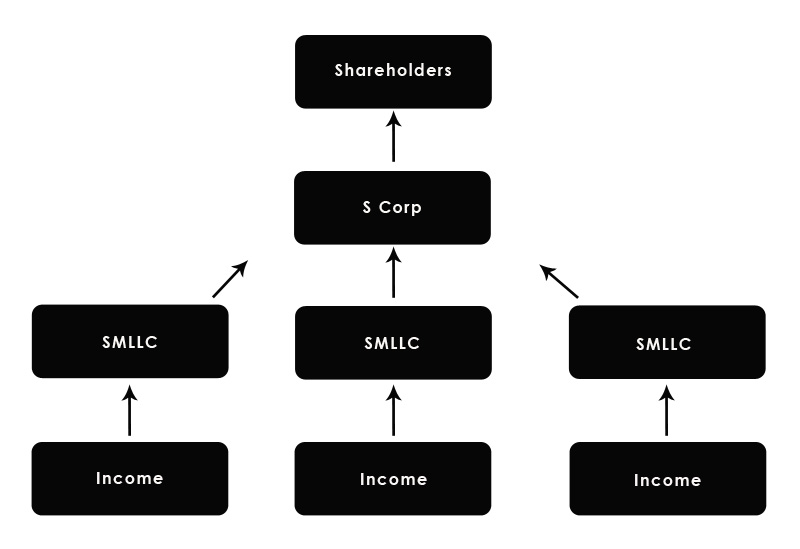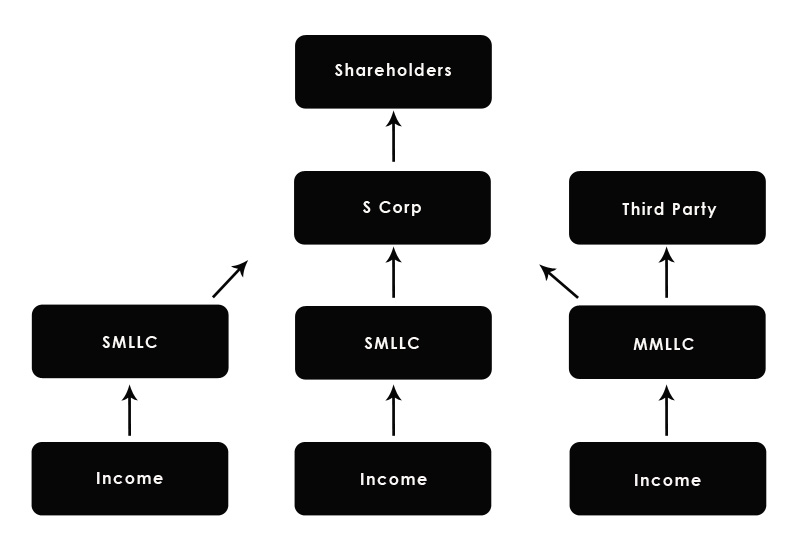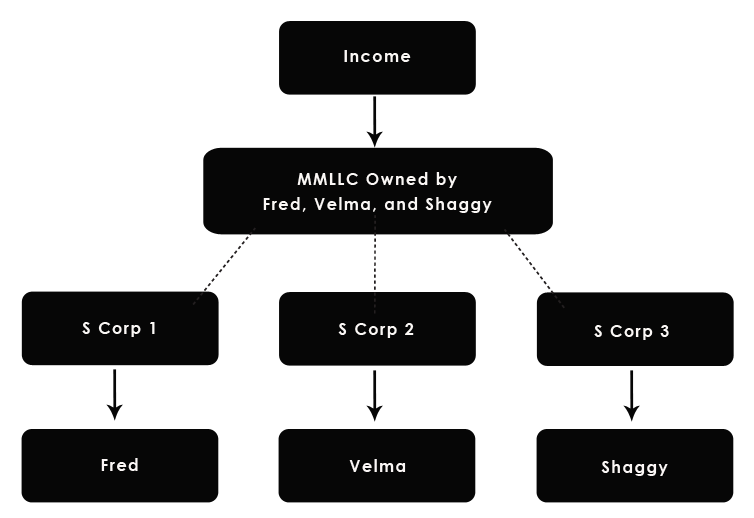
Multi-Entity Business Structures Mini Portal
Posted Saturday, December 30, 2023
Multi-entity business structures can create tax benefits, but more importantly they create flexibility and provide for long-term options when combined with robust operating agreements. Unlike some attorneys and wealth managers, WCG does not automatically recommend complicated business structures. Far too often we see half-baked ideas and unnecessary complication in the pursuit of precision. Rather, we call this the illusion of precision. So many things look cool and sexy on paper with color-coded symbols with arrows going everywhere… this owns 2% of that, that owns 51% of this, the whole thing is owned by 27 different LLCs, and blah blah blah.
Granted, there are times when complication is required, and complication can be elegant is done correctly. Be careful. Get informed. Ask pointed questions. Schematics don’t hold up well in court, but operating agreements and shareholder agreements do… so ensure your pretty picture has some supporting text, preferably signed.
There are certain topic where we concentrate snippets of information that is all interconnected allowing you to get a quick 30,000 foot perspective. This material comes from Chapter 2 of our book titled Taxpayer’s Comprehensive Guide to LLCs and S Corps. You can read it online for free… or a print copy from Amazon, a digital copy from Kindle or a PDF copy from ClickBank.
Here we go…
Holding Company and Operating Company
This is a common arrangement where your operating company leases space from your holding company, such as an office building, warehouse, land, equipment, etc. This can also reduce self-employment taxes in the operating company since some of the available cash will be paid to you as a rent payment, and rental income in this situation is normally not subjected to self-employment taxes.
This is also flexible for the future since you could expand ownership in your operating company without affecting your holding company. Another way to look at the holding company is a vehicle to build wealth separately from your business. [More]
Parent-Child Business Structure 1
You might have two business entities, and you want to combine them but they are also very different. For example, you are a realtor and your spouse is an IT consultant. We could create a holding LLC called Smith Ventures which owns the realtor LLC and the IT consultant LLC. The holding LLC would then make the S Corp election, and all the LLC income would flow into the S corporation as wholly owned subsidiaries. With respects to operating agreements, the subsidiary LLC’s can have a basic operating agreement since its sole member is the holding LLC. The holding LLC might need a robust operating agreement based on your legal needs and estate planning.
Sure, you could have two S Corps, one for you and one for your spouse, but that increases administrative fees such as tax preparation, payroll processing, etc. [More]
Parent-Child Business Structure 2
This is identical to the above situation, but as you can see one of the subsidiary LLCs now has additional ownership outside of you and your spouse. For example, you are an IT consultant and your spouse is a yoga instructor. Your spouse wants to join forces with another yoga instructor, lease a gym, add staff and go crazy with mats and pants. This multi-entity arrangement allows for that. Keep in mind that your spouse would not own the MMLLC subsidiary entity; rather, the S Corp would own a portion of it, and the other portion would be owned by the new member. [More]
Parent-Child Business Structure 3
Another thought along these lines involves a multi-member LLC where you and another non-spouse partner are the members. One of the limitations of an S corporation is that distributions must be made in the same percentage as ownership. So, if you are 50-50 with another shareholder, distributions must also be 50-50.
Backup for a moment. If this multi-member LLC was not taxed as an S corporation, the Operating Agreement could dictate a different schedule of distributions. For example, you and another insurance agent team up. But you want an Eat What You Kill revenue model. In this case, you could be 50-50 partners, but have the distributions be tied to the production of each insurance agent. No problem. In other words your capital accounts are 50-50, but your allocation of profits and losses fluctuate each year. However, if you S Corp elect this to save a few bucks on self-employment taxes, and it blows up.
What can be done? The graphic shows the general business structure. Also, this multi-entity arrangement allows for each owner to have discretion within his or her S Corp for fringe benefits such as company automobiles and paying children, among other benefits. [More]
Quick Sidebar: When getting involved with non-spouse business partners, operating agreements are absolutely necessary. Please read our operating agreements section from our book about some of the basic considerations when drafting operating agreements.
Fee For Service Arrangement
A simpler way to accomplish the same thing as above is to create three entities again, but the multi-member LLC is owned by you and the other guy, not the S corporations. The following is the preferred arrangement for a host of reasons, especially state apportionment of income and business valuation. The S Corps issue consultation, fee for service or management fee invoices to the multi-member LLC in the amount of the revenue split driving the multi-member LLC income down to zero, or some nominal amount like $500.
This business structure is super common with physician groups, insurance agents, financial advisors and other production-based groups that want real time flexibility on the sharing of profits and the tax efficiency of an S corporation. [More]
Fee For Service Arrangement in California
The problem with the previous MMLLC entity structure that issues invoices or makes fee for service payments, is that this works well in most situations except California. It still works in California as a structure, but the tax expense, namely the LLC fee, makes this egregious.
California’s LLCs, including SMLLCs and MMLLCs, have an LLC fee based on gross receipts. Read that again. On gross receipts. If you make a $1,000,000 and have $950,000 in expenses, you still pay a franchise tax, called an LLC fee, on the $1,000,000. The fee is “banded” as we say since it is not a straight calculation based on a percentage.
The MMLLC S Corp would not pay salaries to its shareholders since the income is so low, and there isn’t any cash available. In addition, distributions theoretically should be $0 since all the cash is leaving in the form of payments to the other S Corps. [More]
Holding Company versus Management Company
Holding companies and management companies are not the same thing. One, as the name suggests, holds or owns underlying assets (other businesses). The other offers management services in exchange for fees, and typically doesn’t own underlying assets.
Quite a few entrepreneurs have their hands in a lot of pots, and for various reasons they want to set up multiple entities (typically limited liability companies or LLCs). They might want separate liability protection in their contracts. One entity might have multiple owners or have a separate team of employees with future minority owners. One of the entities might be regulated such as real estate or financial services. Yet another entity might be in a growth phase for a business sale.
Compartmentalization can be important as well to those who like straight lines and organization. The question then becomes whether to use a Holding Company or Management Company arrangement. [More]
Considerations with Multiple Entities
There are some things you need to work through with the multi-entity arrangement, and have detailed in operating agreements (such as naming principles for purposes of professional liability insurance). Depending on your situation, some of these things might be show-stoppers. However, don’t take the first answer as the only answer. Here is a quick list-
- Health Insurance
- Professional Liability Insurance
- Licensing and Compliance
- 401k Plans
- Depreciation of Assets
- Professional Fees (tax prep fee, payroll processing)
- Asset Appreciation
As mentioned, some of these could stop the show. [More]
Multi-Entity Business Structures
Need help with your situation? Do you think you might need to complicate your world with more than one entity? Wondering how to gain tax efficiency alongside flexibility? Let’s chat!
WCG CPAs & Advisors is a small boutique firm in Colorado specializing in small business taxes and advisory services.






